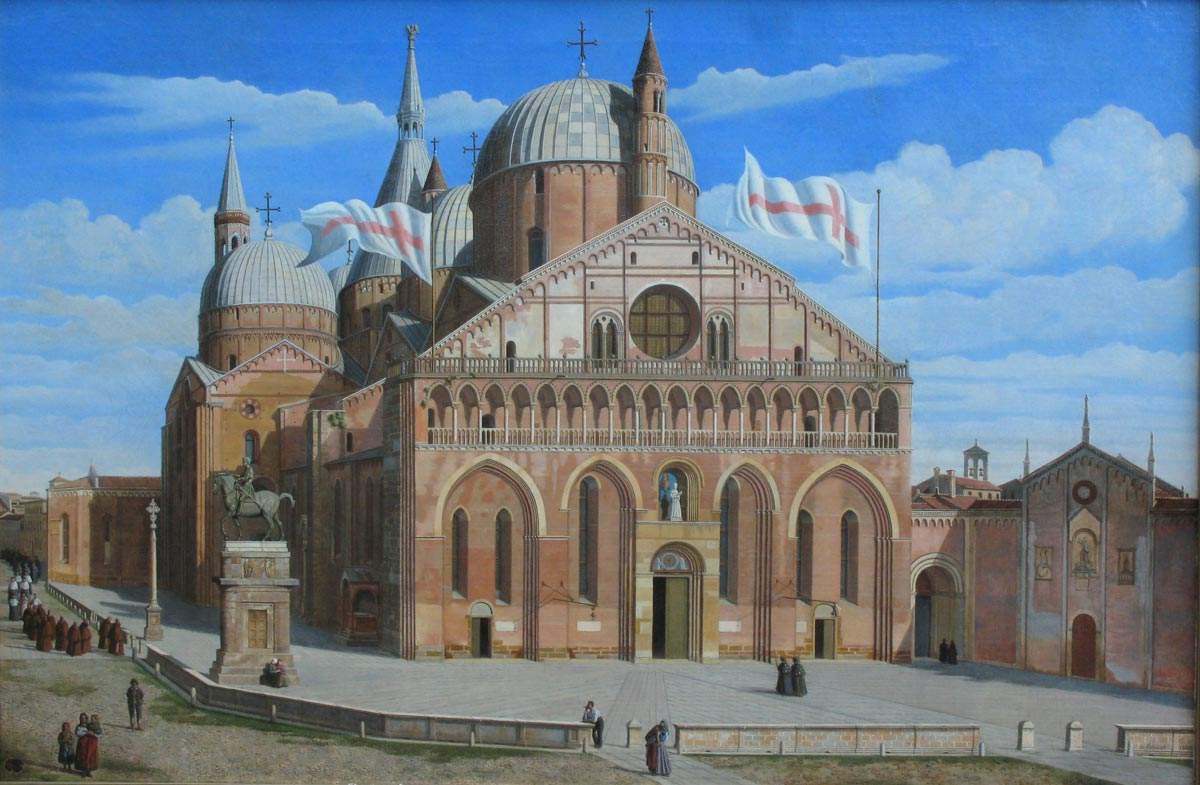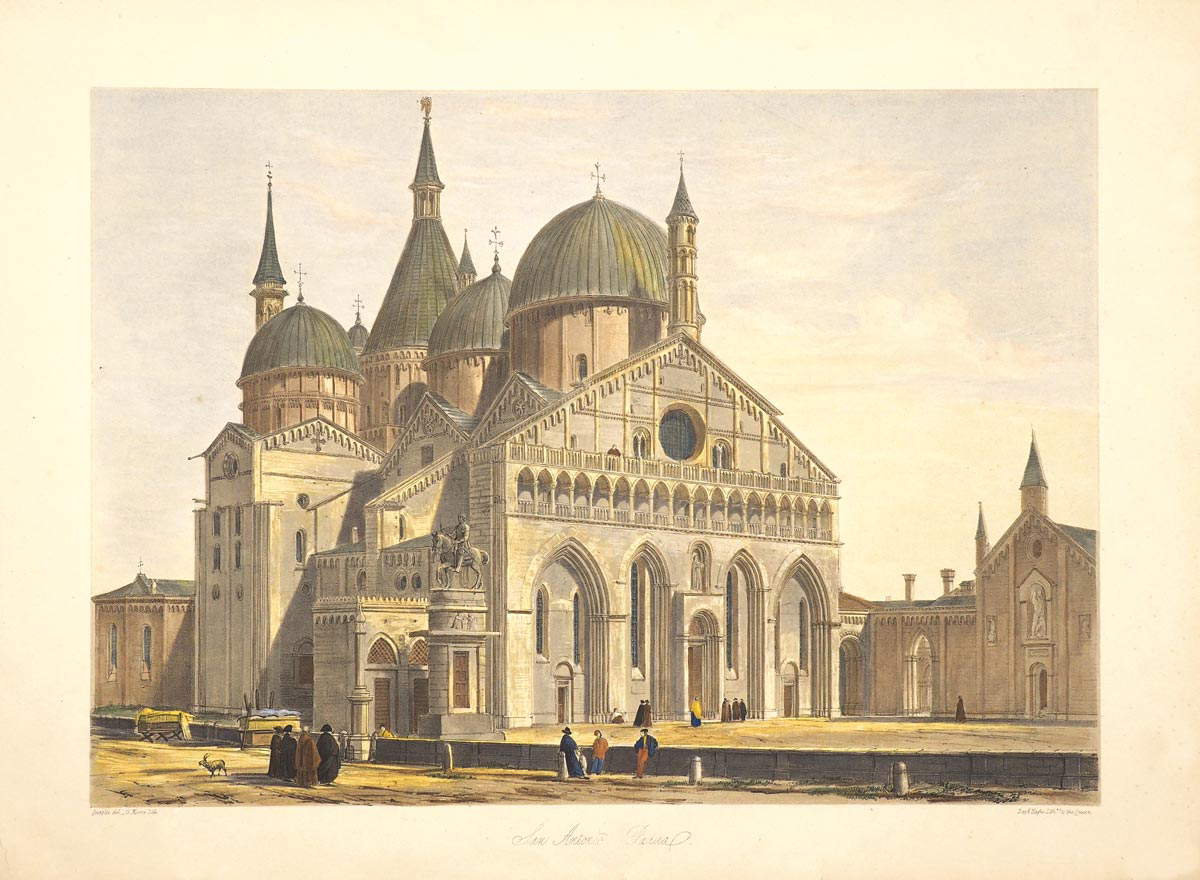by Redazione , published on 02/06/2019
Categories: Events
/ Disclaimer
From May 23 to July 6, 2019, the Antonian Museum of Padua is hosting the exhibition 'The Saint as he was: representations of the Basilica through the centuries'
The Antonian Museum of Padua is hosting, from May 23 to July 6, 2019, the exhibition Il Santo come era: rappresentazioni della Basilica attraverso i secoli, curated by Alessandro Borgato and Giovanna Baldissin Molli. The exhibition aims to tell the story of the evolution of the fabric of the basilica of St. Anthony and the convent from the Renaissance to the contemporary age through ancient books, drawings, paintings, views and original engravings and matrices. The newly restored halls of the Antonian Museum thus display important works, some exhibited for the first time to the public, that tell this story, with direct and unpublished evidence, how the appearance of the basilica changed through the centuries, but also aspects of customs, culture, productive activities and the very identity of Paduan society in its relationship with the saint.
“Eminently urban basilica, shrine and place of pilgrimage to the Saint’s tomb, Franciscan church : we know well by now, from the long and thorough literature, the peculiar characteristics that make this sacred complex unique, extraordinary, not comparable to others, with which it may share, from time to time, parceled aspects, but not the whole of its facies, its building history, its interior furnishings, its relationship with the city, its becoming and its religious, cultural and social relations with the communities of the faithful, devotees, pilgrims, art lovers of tourists, in the nuances in which these too-easy simplifications decline the possible frequenters of the basilica,” declares Giovanna Baldissin Molli, “So today, more than a century after the powerful remodeling carried out by Camillo Boito in the imminence of the seventh centenary of the birth of Anthony of Lisbon and Padua (1895), by what criterion can we attempt to stitch together the printed (for the most part) or painted images, and models depicting the basilica? I would say that more than one story we can better focus on aspects that today seem so taken for granted as we are used to seeing them, but which instead still constitute question marks, on the exterior and interior of the temple, in its relationship with the square, with the privileged directrix of Via del Santo, and with the interior decoration of the church.”
Prominent among the works on display for their importance and historical and artistic value are a very rare 17th-century watercolor depicting moments of city life around the basilica, a 19th-century view of the basilica by Antoine Marie Perrot, rare views by important engravers including Giacomo Ruffoni Father Coronelli, Giorgio Fossati, Pietro Scattaglia, Giovanni Battista Brustolon, Ignazio Colombo, and Pietro Chevalier, some accompanied by their own original copper plates, to fascinating ancient printed works by Father Polidoro, Angelo Portenari, Giovanni Battista Rossetti, and Bernardo Gonzati. The works come from the various collections of the Antonian complex and from private collections, which well illustrate the architectural and artistic aspect of the basilican complex of St. Anthony and the conterminous areas of the capital city of Padua, including through evidence relating to fundamental events in its history, such as the modifications of the Renaissance period, dictated by changes in liturgical usages, the terrible fire of 1749 and the profound alterations in modern times.
“The works on display,” explains Alessandro Borgato, "were chosen because of the subject they exhibit and their relevance to the theme of the exhibition, their importance in historical and artistic terms, and their rarity. Precisely because of its importance, the saint has been represented since the 15th century, and his iconography follows hand in hand with the evolution of printing and its techniques: woodcut, copperplate engraving, etching, aquatint and lithography. A woodcut preserved in the British Museum, dated by Hind between 1470 and 1485, would testify to the existence of a specific iconography of the basilica as early as the 15th century, although in this and again in the 16th century the saint often ’gets lost’ in more or less fantastic depictions of the city of Padua, such as the view contained in Hartmann Schedel’s Liber chronicarum and here well represented by the views contained in the Cosmographia universalis [...], one of the earliest descriptions of the world, by the German cartographer and cosmographer Sebastian Munster. The woodcut Figure of the Church of St. Anthony of Padua contained in the text of Father Polidoro’s ’guidebook,’ printed in Padua in 1590, takes up the above woodcut and becomes a symbol of the Antonian complex in 16th-century religious writings as well as one of the earliest examples of the particular iconography of the basilica in relation to the overall iconography of the city."
“Many of the works on display,” Borgato further emphasizes, “give us valuable images of city life around the basilica. They give us back customs, habits, a busy everyday life around the saint, composed of simple commoners, shrewd merchants, street vendors, devout friars or ordinary citizens caught in some of the habits that mark life. If one end this exhibition wanted to achieve, it was for me related to the idea of travel. It was intended to give the viewer the possibility of being transported from the end of the Middle Ages to the present day, lapping up Renaissance essentiality, the grandiose eighteenth century, the romantic nineteenth century, with their respective different peculiarities. It is a journey that carries with it a baggage of different emotions, all, however, linked to the basilica as a common denominator, as a welcoming home from which to depart and to which to return. The representations of the saint on display go beyond mere documentary data, they describe a city, a territory, they recount lives lived, they are there to represent ourselves today, and the lives of those who over the centuries have strolled the churchyard on a sunny day, walked through the doorway weeping in silence, admired the artistic treasures, paused in the cloister at the foot of the Magnolia or prayed to St. Anthony. The exhibition closes with what could have been the basilica of the saint: in fact, drawings of the project by Alessando Morani and Niccolò Barducci, ranked second and third respectively in the competition promulgated by the Veneranda Arca del Santo in 1897, are on display.”
The exhibition is organized by the Veneranda Arca del Santo with the Museo Antoniano and the Centro Studi Antoniani, under the patronage of the City of Padua and with contributions from the Fondazione Cassa di Risparmio di Padova e Rovigo, Wide Group SpA, an insurance broker specializing in fine art, Alì S.p.A. and the Peruzzo Foundation. Admission is free and for any information visit www.arcadelsanto.org. Below is a selection of works in the exhibition.
![Valerio Polidoro, Le religiose memorie [...], In Venetia, appresso Paolo Meietto (1590; work in one volume, mm 210x150; Padua, Antoniano Complex) Valerio Polidoro, Le religiose memorie [...], In Venetia, appresso Paolo Meietto (1590; work in one volume, mm 210x150; Padua, Antoniano Complex)](https://www.finestresullarte.info/_danae/placeholder.php?colore=e5e5e5&width=750&height=750) |
| Valerio Polidoro, Le religiose memorie [...], In Venetia, appresso Paolo Meietto (1590; work in one volume, mm 210x150; Padua, Complesso Antoniano) |
![Anonymous, Patavium nobilissima et litterarum studijs florentissima Italiae civitas 1617, Taken from Civitates orbis terraurm [...] Cologne, P. von Brachel (1572-1617; copper engraving, 390x484 mm; Private collection) Anonymous, Patavium nobilissima et litterarum studijs florentissima Italiae civitas 1617, Taken from Civitates orbis terraurm [...] Cologne, P. von Brachel (1572-1617; copper engraving, 390x484 mm; Private collection)](https://www.finestresullarte.info/_danae/placeholder.php?colore=e5e5e5&width=750&height=750) |
| Anonymous, Patavium nobilissima et litterarum studijs florentissima Italiae civitas 1617, Taken from Civitates orbis terraurm [...] Cologne, P. von Brachel (1572-1617; copper engraving, 390x484 mm; Private collection) |
 |
| Anonymous, Basilica del Santo (17th century; watercolor on paper, 130x163 mm; Padua, Antoniano Complex) |
 |
| Vincenzo Coronelli, Basilica e monastero del Santo di Padova de’ Min. Conventuali (Late 17th century-early 18th century; copper engraving, 435x700 mm, copper matrix 493x679 mm; Padua, Antoniano Complex) |
![Giorgio Fossati, Side view at the part of the ark showing the damage caused by fire in the domes of the basilica of St. Anthony of Padua [...] (18th century; copper engraving, 350x495 mm; Padua, Antoniano Complex) Giorgio Fossati, Side view at the part of the ark showing the damage caused by fire in the domes of the basilica of St. Anthony of Padua [...] (18th century; copper engraving, 350x495 mm; Padua, Antoniano Complex)](https://www.finestresullarte.info/_danae/placeholder.php?colore=e5e5e5&width=750&height=750) |
| Giorgio Fossati, Side view to the part of the ark showing the damage caused by fire in the domes of the basilica of St. Anthony of Padua [...] (18th century; copper engraving, 350x495 mm; Padua, Antoniano Complex) |
 |
| Antoine Marie Perrot, View of the Basilica of St. Anthony of Pad ua (1842; oil on canvas, 88.6 x 130.8 cm; Gianluca Paniz Private Collection) |
![Domenico Borini, Stanze per l'incendio seguito nel tempio di S. Antonio di Padova [...], Padua, in the Conzatti printing house (1752; work in one volume 262x195 mm; Padua, Antoniano Complex) Domenico Borini, Stanze per l'incendio seguito nel tempio di S. Antonio di Padova [...], Padua, in the Conzatti printing house (1752; work in one volume 262x195 mm; Padua, Antoniano Complex)](https://www.finestresullarte.info/_danae/placeholder.php?colore=e5e5e5&width=750&height=750) |
| Domenico Borini, Stanze per l’incendio seguito nel tempio di S. Antonio di Padova [...], Padua, in the Conzatti Printworks (1752; one-volume work, 262x195 mm; Padua, Antoniano Complex) |
 |
| Francesco Bellucco, Pellegrino del Colle, Part of the sanctuary of Saint Anthony. Prospect of the tribune (Second half of the 18th century; taken from Teatro Prospetico Fabriche più considerate della città di Padova, S.n.t.; Copper engraving, 290x375 mm; Padua, Complesso Antoniano) |
 |
| D. Quaglio - G. Moore, San Antonio - Padua, London, Day & Haghe Lithographers to the Queen (19th century; lithograph, 280x395 mm; Padua, Antoniano Complex) |
 |
| Alfred Guesdon, Jean Jacottet, Padoue, vue prise au dessus de la porte Coda Lunga, Paris, A. Hauser (1849; lithograph, 280x438 mm; Private collection) |
 |
| Padua, how the Basilica of St. Anthony has been represented over the centuries: an exhibition at the Antonian Museum. Photos |
Warning: the translation into English of the original Italian article was created using automatic tools.
We undertake to review all articles, but we do not guarantee the total absence of inaccuracies in the translation due to the program. You can
find the original by clicking on the ITA button. If you find any mistake,please contact us.
![Valerio Polidoro, Le religiose memorie [...], In Venetia, appresso Paolo Meietto (1590; work in one volume, mm 210x150; Padua, Antoniano Complex) Valerio Polidoro, Le religiose memorie [...], In Venetia, appresso Paolo Meietto (1590; work in one volume, mm 210x150; Padua, Antoniano Complex)](https://cdn.finestresullarte.info/rivista/immagini/2019/fn/sant-antonio-valerio-polidoro-religiose-memorie.jpg
)
![Anonymous, Patavium nobilissima et litterarum studijs florentissima Italiae civitas 1617, Taken from Civitates orbis terraurm [...] Cologne, P. von Brachel (1572-1617; copper engraving, 390x484 mm; Private collection) Anonymous, Patavium nobilissima et litterarum studijs florentissima Italiae civitas 1617, Taken from Civitates orbis terraurm [...] Cologne, P. von Brachel (1572-1617; copper engraving, 390x484 mm; Private collection)](https://cdn.finestresullarte.info/rivista/immagini/2019/fn/sant-antonio-anonimo-patavium-nobilissima.jpg
)


![Giorgio Fossati, Side view at the part of the ark showing the damage caused by fire in the domes of the basilica of St. Anthony of Padua [...] (18th century; copper engraving, 350x495 mm; Padua, Antoniano Complex) Giorgio Fossati, Side view at the part of the ark showing the damage caused by fire in the domes of the basilica of St. Anthony of Padua [...] (18th century; copper engraving, 350x495 mm; Padua, Antoniano Complex)](https://cdn.finestresullarte.info/rivista/immagini/2019/fn/sant-antonio-giorgio-fossati-basilica-incendio.jpg
)

![Domenico Borini, Stanze per l'incendio seguito nel tempio di S. Antonio di Padova [...], Padua, in the Conzatti printing house (1752; work in one volume 262x195 mm; Padua, Antoniano Complex) Domenico Borini, Stanze per l'incendio seguito nel tempio di S. Antonio di Padova [...], Padua, in the Conzatti printing house (1752; work in one volume 262x195 mm; Padua, Antoniano Complex)](https://cdn.finestresullarte.info/rivista/immagini/2019/fn/sant-antonio-domenico-borini-stanze-per-l-incendio.jpg
)



